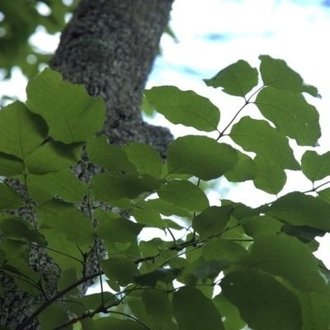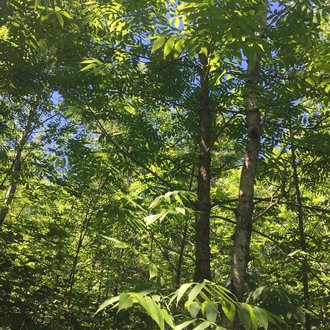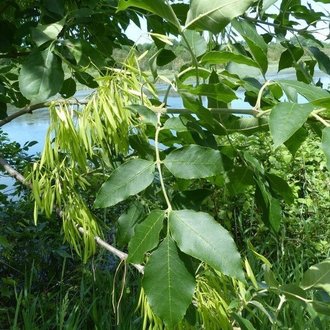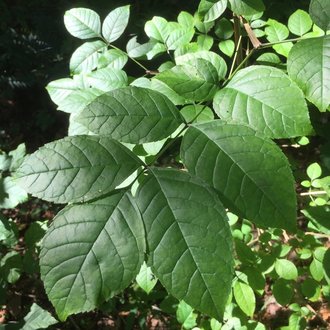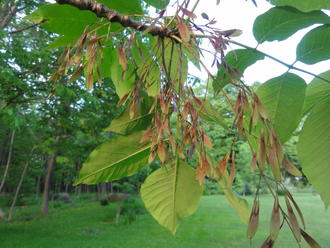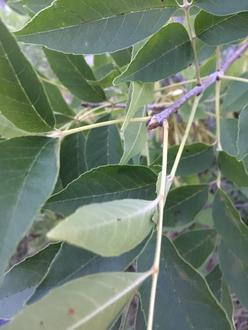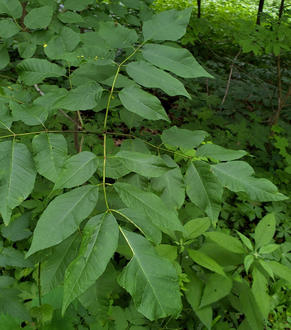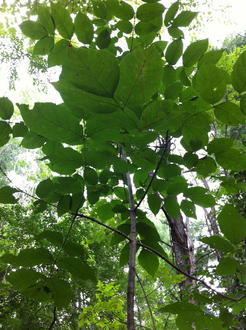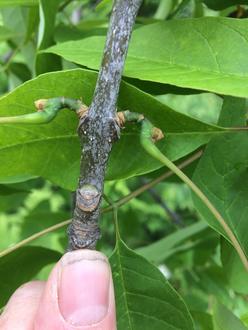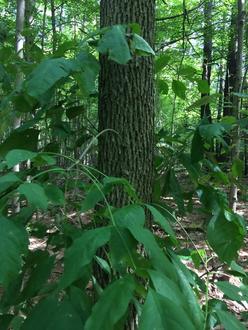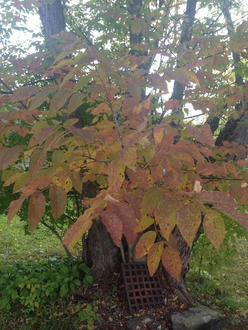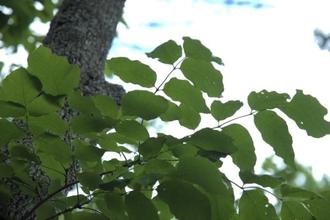White Ash (Fraxinus americana L.)
Also known as American ash.
↑Summary
A tree species native to eastern North America, found on mesic sites in early to mid stages of forest succession.
↑Range - Expand
| Legend | Color |
| Native | |
| Introduced or Not Present | |
| Native or Not Present | |
| Native or Introduced or Not Present |
This tentative map is based on our own research. It may have limited data on Canada and/or Mexico, and there is some subjectivity in our assignment of plants as introduced vs. expanded. Read more in this blog post.
Although this plant occurs somewhere in each of these regions, it may only occur in a small part of some or all of them.
↑Description & Identification
A tree to 60 to 70 feet (18-21 m). Leaves are opposite and pinnately compound, with 5-9 (most frequently 7) leaflets. Each leaflet has a distinct stalk (petiolule) which is not winged. Leaf underside is often pale. Crown is narrow and pyramidal in forests, and rounded on open sites. Fruit is a samara, with a seed positioned at the base of the samara and taking up well under 1/2 its length. Fall color includes yellow, orange, maroon and dark purple colors, often simultaneously or even on the same leaf, while leaves are still on trees. The prevalence of the dark purple color often makes this tree stand out from other deciduous trees.
Some aspects of this species are highly variable; varieties exist with pubescent twigs and petioles, as well as those where twigs and petioles are glabrous. Leaf margins may be serrated or smooth. Leaflet shape is also variable, from oblong to ovate, and underside of leaf surface is not always pale.
As few trees have opposite, pinnately compound leaves, white ash is usually only confused with other ash species.
↑Similar Plants
↑Habitat
Mostly found in hardwood forests or mixed forests with mostly hardwoods and a small number of conifers, with the best growth on deep, well-drained, moist soils. In the northeast, mostly found on middle slopes in mesic conditions, and absent or rare on dry slopes and colder sites at higher elevations. A major component of mixed mesophytic forests and other mesophytic forests. Farther south, in the coastal plain and central US, found on slightly elevated sites in the floodplains of major streams.
Prefers moist sites but generally limited to well-drained sites that do not experience frequent flooding. Strongly prefers soils high in nitrogen.
Found in early-to-intermediate stages of forest succession, but usually absent from climax communities.
Fares best in areas with lower levels of air pollution. Susceptible to ground-level ozone, and nitrogen and sulfur oxides from acid rain, all of which may stress trees and leave them vulnerable to other pathogens.
↑Life Cycle
White ash is relatively fast-growing but can be long-lived. In forests, it maintains both a seed bank and seedling bank, but requires gaps of higher-light conditions in order to reach maturity.
Seeds germinate on the surface, and may germinate in exposed mineral soil, leaf litter, or decaying organic matter. Germination occurs in the spring and is triggered by moisture and warm temperatures. Seedlings are shade tolerant, and can survive for a few years in low-light conditions, but will eventually die under a closed canopy of shade-tolerant species. Seedlings germinating in higher-light conditions, or seedlings released from shade by a gap, will quickly grow to reach canopy height.
Under most conditions, white ash grows very straight. When mixed with other trees, it develops a long, straight trunk free of lower branches, both due to less frequent branching, and lower branches dying off as they are shaded. On open sites, forms a shorter bole before branching, and forms larger, more persistent horizontal branches. Trees begin flowering and fruiting when the trunk reaches about 3-4 inches in diameter, but flower and seed production remains low until the tree reaches 8-10 inches in diameter.
Seeds are wind-dispersed, and exhibit cold dormancy. Not all seeds germinate in the first year, and the seeds form a short-term seed bank, some germinating as late as in their fourth year.
Trees resprout from the root crown after being top-killed by fire or mechanical damage. Younger trees are more likely to resprout in such a manner.
Mature trees have some fire resistance, but can still be easily top-killed by severe fires. Often, fire causes injury to a tree but does not immediately kill it, and the tree is then killed by insects and disease.
↑Faunal Associations
Numerous insects, both native and introduced, feed on white ash, including large numbers of butterflies and moths. Some of the better-known species include the eastern tiger swallowtail (Papilio glaucus) and various sphinx moths. Numerous beetles eat the bark and wood. Recently, one such beetle, the emerald ash borer (Agrilus planipennis), was introduced from northeast Asia; this species has been particularly damaging to North American ashes, although less susceptible than the green ash (Fraxinus pennsylvanica) and black ash (Fraxinus nigra). There are also sawflies, aphids, and other true bugs that eat this species.
The seeds are eaten by medium-to-large birds, and also by small mammals including mice and squirrels.
Older trees are often preferred for nesting sites by various cavity-nesting birds. Woodpeckers make frequent use of these trees both as a source of insect food and for creating nesting sites, which are then often utilized by other bird species.
↑Uses
White ash is a major timber species. It is particularly valued for its strength and shock resistance, and until recently, its widespread availability. It is easily workable and can resemble oak when stained. It is the wood used for almost all baseball bats, and is also used in tool handles and other turned objects, especially handles of hammers and shovels where impact-resistance is critical. It is also used in flooring and boxes and crates.
White ash was formely widely planted as a landscaping plant, including as a shade tree and stree tree, where it was valued for its tolerance of urban soil conditions and suitability to a wide range of different sites, including alkaline soil and moderate drought; it is rarely planted nowadays due to its susceptibility to the Emerald Ash Borer, as well as other factors causing its decline, especially in urban settings where it is exposed to air pollution.
White ash has also been used to reclaim surface (strip) coal mines, where it is suitable for sites with pH of at least 4.0. Due to its high nitrogen needs it does best on these sites when combined with nitrogen-fixing plants such as black locust (Robinia pseudoacacia) or alder.
↑Related Plants
20 Fraxinus species are found in the wild in North America, all but two of them native. Of these, green ash (Fraxinus pennsylvanica) overlaps most in range. Black ash (Fraxinus nigra) also overlaps with this species in the north, and blue ash (Fraxinus quadrangulata) in the central US, and pumpkin ash (Fraxinus profunda) in the southeast.
↑Notes
This species has rapidly gone from being one of the most abundant tree species in eastern North America to being considered critically endangered due to the introduced emerald ash borer. Although its numbers are still large, and it shows some natural resistance to the borer, its populations are plummeting and its future is uncertain.
↑Links & External Resources
• White Ash | The Wood Database (About This Site)
• White Ash | Fire Effects Information System (FEIS) (About This Site)
• Fraxinus americana (White Ash) | Illinois Wildflowers (About This Site)
• Fraxinus americana (White Ash) | USDA PLANTS Database (About This Site)
• Fraxinus americana | Go Botany (About This Site)
• Fraxinus americana (White Ash) | Missouri Botanical Garden Plant Finder (About This Site)
• White Ash | Virginia Tech Dendrology Factsheets (About This Site)
• White Ash | Silvics of North America (About This Site)
• Fraxinus americana | Biota of North America Project (BONAP) (About This Site)
• Fraxinus americana | NatureServe Explorer (About This Site)
• White Ash | Maryland Biodiversity Project (About This Site)
• Fraxinus americana L. var. americana (White Ash) | Digital Atlas of the Virginia Flora (About This Site)
• Fraxinus americana L. var. biltmoreana (Beadle) Wright ex Fern. (Biltmore Ash, Biltmore White Ash) | Digital Atlas of the Virginia Flora (About This Site)



